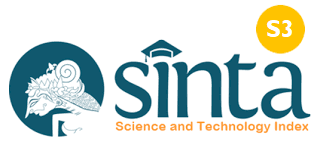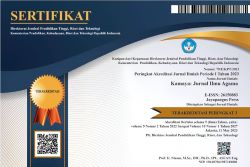Implementasi Ajaran Paravidya dan Aparavidya Dalam Memerangi Hoax Sebagai Upaya Membangun Sumber Daya Manusia Hindu Unggul
DOI:
https://doi.org/10.37329/kamaya.v6i2.2488Keywords:
Paravidya, Aparavidya, Hoax, Hindu Human ResourcesAbstract
Social media basically has a big influence on the dimensions of human life, because humans in their various activities cannot be separated from the existence of social media. Social media will have a good impact, if people understand and use it wisely, but it will have a bad impact if they don't use it wisely. This research principally aims to understand how Hindu teachings are to be wise and critical in managing information on social media, bearing in mind that there are two types of knowledge in Hinduism namely Paravidya and Aparavidya. The method used in this study is a qualitative method with a critical discourse analysis approach. The results of this study indicate that Paravidya and Aparavidya knowledge is the main basis that must be understood by Hindus in relation to managing information on social media. By having these two knowledges, humans can have a balance between worldly and spiritual life. In addition, the teachings of Paravidya and Aparavidya are used as a basis for analyzing further information in the process of pratyaksa pramana (namely by direct observation using the five senses), anumana pramana understands the phenomena that occur by examining them through the causal process, then upamana pramana namely through doing the process of comparison or comparison, and pramana's words, namely through instructions from people who have authority about this information. By understanding this, Hindus will be wise in controlling the information they obtain on social media.
References
Adnyana, P. E. S. (2019). Brahma Vidyā dalam Kitab Īśā Upaniṣad (Studi Teologi Hindu). Pangkaja: Jurnal Agama Hindu, 22(2), 44–54.
Ayun, P. Q. (2015). Fenomena Remaja Menggunakan Media Sosial dalam Membentuk Identitas Diri. Yogyakarta: Universitas Ahmad Dahlan
Kosasih, E., Raharusun, A. S., Dalimunthe, R. P., & Kodir, A. A. (2020). Literasi Media Sosial dalam Pemasyarakatan Moderasi Beragama dalam Situasi Pandemi Covid-19. Digital Library UIN Sunan Gunung Djati Bandung, 3.
Maswinara, I. W. (1999). Sistem Filsafat Hindu (Sarwa Darśana Samgraha). Surabaya: Paramita.
Maswinara, I. W. (2005). Rg Veda Samhita. Surabaya: Paramita
Mertayasa, I. K. (2019). Hoax dalam Perspektif Hindu. Satya Vidya: Jurnal Studi Agama, 2(1), 101–120.
Nasrullah, R. (2015). Media Sosial Perspektif Komunikasi, Budaya, dan Sosioteknologi. Bandung: Simbiosa Rekatama Media.
Nedu, O. C. (2019). The Pulsatory Play Of Reality. Bewilderment And Self-Rediscovery In Māndūkya And Kaivalya-Upanisad. Danubius: Taylor France.
Purnomo, R. A. (2019). Brahman Tattwa Dalam Kena Upanisad. Jurnal Yoga Dan Kesehatan, 2(2), 150–157.
Puspadewi, I. D. A., & Siswadi, G. A. (2022). Penggunaan Media Sosial Instagram dalam Membentuk Citra Diri Remaja pada Santy Sastra Public Speaking. Anubhava: Jurnal Ilmu Komunikasi HIndu, 2(1), 213–224.
Rahadi, D. R. (2017). Perilaku Pengguna Dan Informasi Hoax Di Media Sosial. Jurnal Manajemen Dan Kewirausahaan, 5(1), 58–70.
Segara, I. N. Y. (2016). “Duduk Dekat di Bawah Guru” dan Transformasinya: Kajian atas Kitab Upanisad dalam Ajaran Hindu. Jurnal Lektur Keagamaan, 14(1), 135–152.
Siswadi, G. A. (2021). Abhyāsa dan Vairāgya Dalam Filsafat Yoga Sūtra Patañjali Sebagai Upaya Menghindari Berita Palsu Di Media Sosial. Widya Katambung, 12(2), 52–62.
Siswadi, G. A. (2022). Logika dan Metode Penalaran dalam Perspektif Filsafat Nyāya Darśana. Sophia Dharma: Jurnal Filsafat, Agama Hindu Dan Masyarakat. Vol. 5, No. 2., 5(2), 36–51.
Siswadi, G. Agus., & Puspadewi, I. D. A. (2020). Beragama Tanpa Rasa Takut: Upaya Menjawab Tantangan Umat Hindu Masa Kini. Denpasar: Nilacakra.
Subramaniam. (2007). Mahabharata. Surabaya: Paramita.
Sura, I. G. (1985). Pengendalian Diri dan Etika dalam Ajaran Hindu. Jakarta: Hanuman Sakti.
Surada, I. M. (2019). Kebohongan dan Hoaks dalam Agama Hindu. In I. G. Suwantana & I. P. A. Suhardiana (Eds.), Seminar Nasional Filsafat (Senafi I) Hoaks dalam Perspektif Filsafat. Denpasar: IHDN Press.
Wirawan, I. M. A., Sumadi, I. K., & Suwindia, I. G. (2019). The Study Of Kaṭha Upaniṣad Text And Its Implementation At Sai Study Group Denpasar. Jurnal Penelitian Agama Hindu, 3(2), 112–126.
Zahid, A. (2019). Sensualitas Media Sosial di Era Globalisasi: Kajian Sosiologi Media Marshall McLuhan Sebagai Analisis Media Masa Kini. Jurnal Sosiologi USK Media Pemikiran & Amp; Aplikasi., 13(1), 1–14.
Downloads
Published
How to Cite
Issue
Section
License
Copyright (c) 2023 Kamaya: Jurnal Ilmu Agama

This work is licensed under a Creative Commons Attribution-ShareAlike 4.0 International License.
An author who publishes in the Kamaya : Jurnal Ilmu Agama agrees to the following terms:
- Author retains the copyright and grants the journal the right of first publication of the work simultaneously licensed under the Creative Commons Attribution-ShareAlike 4.0 License that allows others to share the work with an acknowledgement of the work's authorship and initial publication in this journal
- Author is able to enter into separate, additional contractual arrangements for the non-exclusive distribution of the journal's published version of the work (e.g., post it to an institutional repository or publish it in a book) with the acknowledgement of its initial publication in this journal.
- Author is permitted and encouraged to post his/her work online (e.g., in institutional repositories or on their website) prior to and during the submission process, as it can lead to productive exchanges, as well as earlier and greater citation of the published work (See The Effect of Open Access).
Read more about the Creative Commons Attribution-ShareAlike 4.0 Licence here: https://creativecommons.org/licenses/by-sa/4.0/.





